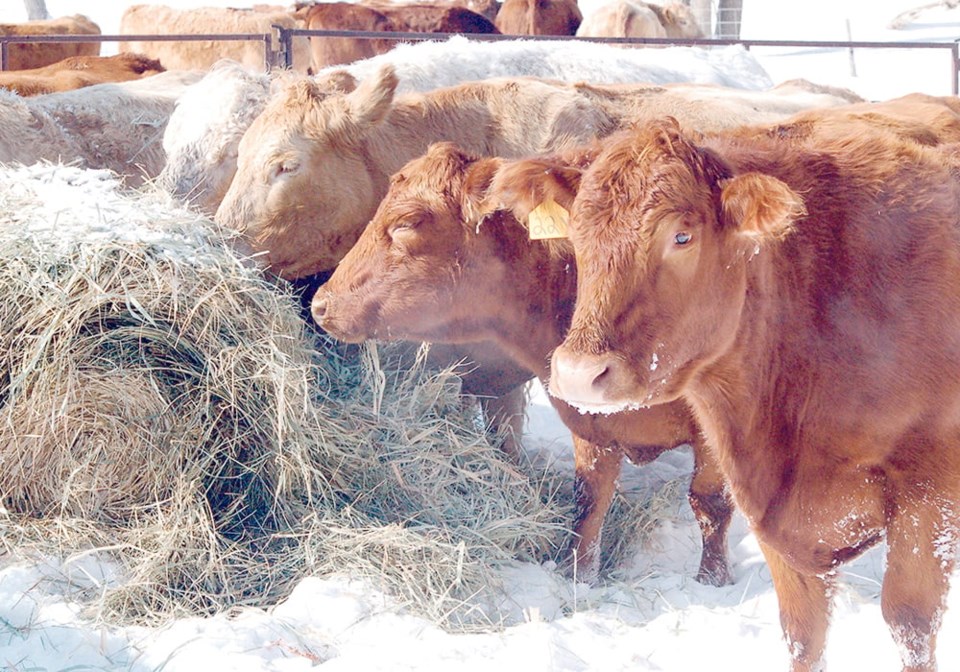WESTERN PRODUCER — Bloat, the distension of the rumen, is probably seen less frequently in cattle production today with producers using total mixed rations, but cases can still occur and we must be ready.
Frothy bloat can quickly turn from serious to death and yet timely treatment is very effective with no lingering consequences. Two incidences of bloat (one frothy and one free gas) on expensive purebred animals at a cattle show prompted this article.
All cattle producers may have to deal with cattle bloat. The lush second-cut alfalfa hay is a risk but sometimes it may be the animal’s inability to belch away the gas that leads to bloat.
Cattle producers must always be prepared to treat it.
It is important to differentiate between free gas and frothy bloat. Once treated appropriately, one must determine if there are other cases that might also require treatment or if there are management or feed changes that must be made to avoid future problems.
Producers should realize their good fortune when they are able to recognize and treat a frothy bloat in time. These bloats are recognizable by the large distension of the rumen on the left side. Pain and a reluctance to walk are bad signs and one must act quickly. To see how much time you may have, grab loose skin over the distended area. If you can get it to fold you have some time, but if the skin is tight, act as quick as you can.
I think every farm should equip itself with a good stomach tube and a speculum. A stomach pump would be nice but for the smaller operation, a funnel can work to administer the medication. Put the speculum in the mouth first and run the tube through the inside of it. This is so cattle don’t chew on the tube, collapsing it and, worst-case scenario, chewing it off and swallowing it. There have been multiple cases over the years of cattle chewing off and swallowing a length of hose. This may necessitate surgery to get the hose out, so use a speculum.
The products available to treat bloat are called Anti-Gas, Bloat Lax, or Bloat-Eze and usually contain dioctol. They usually have a bit of a spearmint or other taste and are good at reducing a frothy bloat.
It allows the bubbles to form free gas to be burped out. Mineral oil can also be used but I like to flavour it with something like anti-Gas first. The bloat treatments can drench a calf and the individual doses come with a long-necked container. I prefer to mix it with water, use the tube to get out whatever gas I can, and then pump in the treatment. If pressured, you may be able to get some gas off before pumping product in.
If the situation is life threatening for the animal, we may need to pierce the abdomen with a trocar. I like to use the medical approach, but if you keep a 14-gauge, two-inch needle, there may be an occasion to place the needle into the top area of distension to release enough gas to alleviate the situation.
Once treated with Anti-Gas, if it is really a frothy bloat problem, improvement should come within 15 minutes so the animal must be watched closely in case trocarization is necessary.
If the distension doesn’t come down, it may be a free gas bloat problem, in which case with tubing you often will hit the pocket and the bloat will come down like a balloon.
Free gas bloats may occur when an animal can’t expel the gas and generally, they don’t get as tight, but I have seen some where they still go down and it becomes life threatening, so treat all bloats seriously.
There was a product called Alfa-sure that was added to water sources for cattle pasturing on heavy stands of alfalfa. It was essentially 100 percent effective but the product is no longer on the market. There was research going on toward getting an alfalfa species that had low-bloat potential but I think at the same time production was lessened considerably. There are also Rumensin CRC boluses that help reduce the incidence of bloat.
Changing rations too quickly can lead to bloat. A saying that has been around for a long time is we kill the animals with kindness so always watch how quickly we change rations and watch the level of alfalfa and other legumes in the diet.
If putting cattle onto a worrisome pasture, put them out with full stomachs and preferably when the crop is coarser and not in the morning if dew is on the leaves.
Producers should keep equipment and product to treat bloat on hand. If treatment doesn’t work, it may be something else.
You should work with your veterinarian on prevention if bloat incidences start to increase.
If the animal is distended on both sides, other problems such as a torsion could be the real issue. This is caused by an intestinal blockage from a hairball or severe peritonitis.
Bloat treatments should work if it is a case of frothy bloat. Often, the most expensive growthy animals are the ones that bloat, so always be prepared because this is one case where you can save a life just by being ready.
Roy Lewis works as a veterinarian in Alberta.




